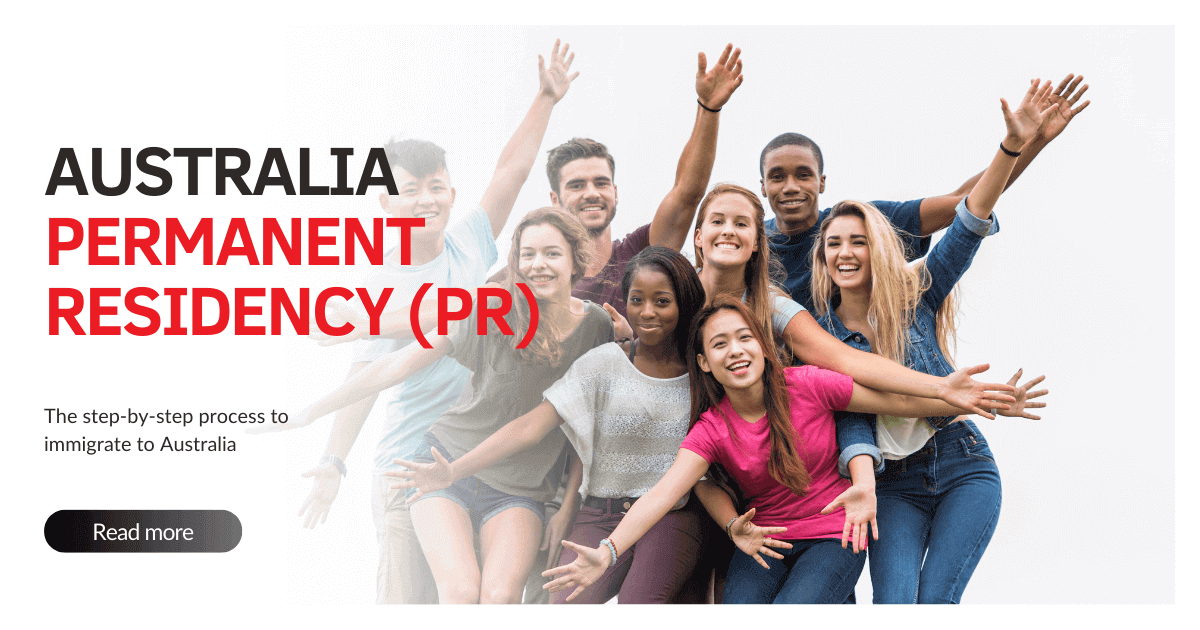Step-by-Step Process to Australia Permanent Residency in 2023

Australia’s attractive immigration policies and opportunities make it a sought-after destination for skilled professionals worldwide. If you aspire to become an Australian permanent resident and enjoy the numerous benefits it offers, understanding the PR process is crucial. In this article, we will delve into the essential information regarding Australian Residency and provide a step-by-step guide to help you prepare your application.
Australian Permanent Residency (PR) is a point-based visa that enables individuals to live, work, and settle in Australia permanently. PR visa holders can reside in Australia for five years and apply for citizenship after spending four years there.
Having an Australia Permanent Residency (PR) visa offers numerous benefits. Here are some of the key advantages:
- Permanent Residency Status: With an Australian PR visa, you have the right to live and work in Australia indefinitely. It provides stability and security, allowing you to build a long-term life in the country.
- Work Opportunities: PR visa holders have unrestricted work rights in Australia. They can work for any employer in any occupation, giving them a wide range of employment opportunities. There are no restrictions on the duration of employment or the need for employer sponsorship.
- Social Security Benefits: As a PR visa holder, you are eligible for various social security benefits and services provided by the Australian government. These include healthcare benefits through Medicare, access to educational institutions, and social welfare assistance.
- Education Opportunities: Australia has a high-quality education system, and PR visa holders are eligible for domestic student fees. This can significantly reduce the cost of education for yourself and your family members, including children.
- Healthcare System: Australia has a renowned healthcare system, and PR visa holders are covered by Medicare, the country’s publicly funded healthcare program. This provides access to a wide range of medical services and subsidies for prescription medications.
- Sponsor Family Members: Australian PR visa holders can sponsor their eligible family members, including spouses, children, and parents, to join them in Australia. This allows for family reunification and the opportunity to live together as permanent residents.
- Pathway to Citizenship: Holding an Australian PR visa is often a pathway to Australian citizenship. After meeting the residency requirements, PR visa holders can apply for citizenship, which provides additional rights and benefits, such as the ability to vote and obtain an Australian passport.
- Travel Flexibility: Live, Work, and Travel Anywhere in Australia With a PR visa, you have the freedom to live, work, and travel anywhere within Australia, enjoying the diverse landscapes, cities, and regions that the country has to offer.
- Access to Financial Services: Having an Australian PR visa enhances your access to financial services, such as loans, mortgages, and investment opportunities. It provides greater financial stability and flexibility for your personal and business endeavors.
- Security and Legal Protection: Australian PR visa holders are protected by Australian law, ensuring their rights and safety. They are entitled to legal protection and can seek assistance from various government agencies in case of disputes or issues.
- Easy Travel to New Zealand: Australian PR visa holders enjoy the convenience of easy travel to neighboring New Zealand. You can explore the stunning landscapes, cultures, and attractions of both countries without the need for additional visas.
It’s important to note that the specific benefits may vary depending on the type of PR visa you hold and any conditions attached to it. It’s advisable to refer to official Australian government sources or consult with a registered migration agent for detailed information regarding the benefits of specific PR visas.
The Australian Permanent Residency (PR) process typically consists of three stages.
- Australia Skill Assessment: Applicants need to undergo a skill assessment through a designated assessment body. This involves submitting the required documents and evidence to validate their qualifications and work experience. It is essential to submit the requirements promptly to receive a faster response.
- Australia PR Visa Approval: After submitting the necessary documents, the Department of Home Affairs (DHA) thoroughly evaluates the applicant’s profile. They assess factors such as age, education, work experience, English language proficiency, and other criteria. If the applicant meets the specific requirements, they are granted a PR visa.
- Preparation for Departure: Once the applicant receives the Australia PR visa approval, they need to prepare for their departure to Australia. The initial entry date mentioned on the visa grant letter indicates when they should move to Australia. It is important to plan and arrange for accommodation, travel, and other logistics before relocating.
In recent times, the Australian government has made the PR process more accessible for Indians through the Skilled Independent Visa (subclass 189) and Skilled Nominated Visa (subclass 190). This includes an agreement between Australia and India to facilitate easy immigration paths for skilled professionals and students. These pathways provide opportunities for Indians to pursue permanent residency in Australia based on their skills and qualifications.
To be eligible for Australian PR, applicants typically need to meet certain requirements, including:
- Age: The maximum age limit for most skilled migration programs is 45 years or younger.
- Points Requirement: Applicants need to score a minimum of 65 points in the Australian points grid.
- Skills Assessment: Applicants must undergo a valid skills assessment conducted by a designated assessment authority. This assessment verifies the qualifications and work experience relevant to the nominated occupation.
- English Language Proficiency: Applicants can provide their scores from language proficiency tests like IELTS (International English Language Testing System) or PTE (Pearson Test of English).
- Health Insurance: Applicants are required to have adequate health insurance coverage during their stay in Australia. This ensures access to necessary healthcare services.
- Police Verification Certificate: Applicants and their dependents need to provide police verification certificates from all the countries they have lived in for a certain period. This is to ensure that they meet the character requirements and do not pose a risk to public safety.
- It is important to note that these eligibility criteria may vary depending on the specific visa subclass and program under which an individual is applying for Australian PR. It is advisable to refer to the official government websites or consult with a registered migration agent for the most up-to-date and accurate information.
Australia PR requirements
| Category | Maximum Points |
|---|---|
| Age (25-32 years) | 30 points |
| English proficiency (8 bands) | 20 points |
| Work Experience outside Australia (8-10 years) | 15 points |
| Work Experience in Australia (8-10 years) | 20 points |
| Education (outside Australia) – Doctorate degree | 20 points |
| Niche skills such as Doctorate or master’s degree by research in Australia | 10 points |
| Study in a regional area | 5 points |
| Accredited in community language | 5 points |
| Professional year in a skilled program in Australia | 5 points |
| State sponsorship (190 visa) | 5 points |
| Skilled spouse or de facto partner (Age, Skills & English language requirements to be met) | 10 points |
| Spouse or de facto partner with ‘competent English’ (No need to meet Skills requirement or age factor) | 5 points |
| Applicants without a spouse or de facto partner or where a spouse is an Australian citizen or PR holder | 10 points |
| Relative or regional sponsorship (491 visa) | 15 points |
Some of the key points from the article you provided on the step-by-step process to immigrate to Australia:
- Assess Your Eligibility: The first step is to determine if you meet the eligibility criteria for Australian permanent residency. Factors such as age, language proficiency, education, work experience, and skills are taken into consideration.
- Choose the Right Visa Category: Australia offers several visa categories, each with its own requirements and benefits. It’s important to identify the visa category that aligns with your qualifications and goals, whether it’s skilled migration, family sponsorship, or business innovation.
- Submit Expression of Interest (EOI): For skilled migration, you need to submit an EOI through the SkillSelect system. This expresses your interest in migrating to Australia and provides information about your skills, occupation, and other relevant details.
- Receive an Invitation: If your EOI is selected from the SkillSelect pool, you will receive an invitation to apply for the visa. The invitation is based on factors such as your points score and the demand for your occupation.
- Lodge Your Visa Application: Once you receive the invitation, you can proceed to lodge your visa application. This involves providing extensive documentation, including proof of identity, education qualifications, English language proficiency, health assessments, and character clearances.
- Undertake Medical and Character Assessments: As part of the visa application process, you will need to undergo medical examinations to ensure you meet Australia’s health requirements. Additionally, you must provide police certificates to demonstrate good character and integrity.
- Wait for Visa Processing: After submitting your application, you will need to wait for the Department of Home Affairs to process your visa. Processing times can vary depending on the visa category and individual circumstances.
- Visa Grant and Travel to Australia: Once your visa is approved, you will receive a visa grant notification. You can then make arrangements to travel to Australia and commence your new life as a permanent resident.
- Comply with Visa Conditions: It’s crucial to comply with the conditions attached to your visa. These may include requirements related to employment, residency, and any obligations associated with specific visa categories.
- Apply for Australian Citizenship (Optional): After fulfilling the requirements, you may choose to apply for Australian citizenship, which provides additional rights and benefits, such as the ability to vote and access certain government services.
Please note that this summary provides an overview of the process and does not cover all the intricate details and requirements involved. It’s always advisable to consult with a registered migration agent or the official Australian government websites for the most up-to-date and accurate information.
Recent Post

Transform Your Career Trajectory With Commercial C
Apr 04, 2024

Interesting Facts About Commercial Cookery Courses
Mar 04, 2024

6 Tips to Manage the Restaurant Kitchen Efficientl
Feb 06, 2024

Top Soft Skills Seeks In 2024 By Employers
Jan 15, 2024

Advantages of a Commercial Cookery Certification
Dec 12, 2023

Nov 21, 2023

Transform Your Passion for Baking into a Flourishi
Nov 17, 2023

Distinguishing the Roles: Chef vs. Kitchen Manager
Sep 18, 2023

Starting a Food Business in Australia – Hire
Sep 04, 2023

Financing Strategies for Food Entrepreneurs : Navi
Aug 22, 2023
CONTACT US
We are always happy to help out whatever way we can
